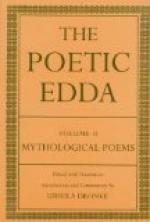In the Old English poems allusion is made only to the second part of the story; there is no reference to the legend of the enchanted brides, which is indeed distinct in origin, being identical with the common tale of the fairy wife who is obliged to return to animal shape through some breach of agreement by her mortal husband. This incident of the compact (i.e., to hide the swan-coat, to refrain from asking the wife’s name, or whatever it may have been) has been lost in the Voelund tale. The Continental version is told in the late Icelandic Thidreks Saga, where it is brought into connexion with the Volsung story; in this the story of the second brother, Egil the archer, is also given, and its antiquity is supported by the pictures on the Anglo-Saxon carved whale-bone box known as the Franks Casket, dated by Professor Napier at about 700 A.D. The adventures of the third brother, Slagfinn, have not survived. The Anglo-Saxon gives Voelund and Boedvild a son, Widia or Wudga, the Wittich who appears as a follower of Dietrich’s in the Continental German sources.
The Volsungs.—No story better illustrates the growth of heroic legend than the Volsung cycle. It is composite, four or five mythical motives combining to form the nucleus; and as it took possession more and more strongly of the imagination of the early Germans, and still more of the Scandinavians, other heroic cycles were brought into dependence on it. None of the Eddic poems on the subject are quite equal in poetic value to the Helgi lays; many are fragmentary, several late, and only one attempts a review of the whole story. The outline is as follows: Sigurd the Volsung, son of Sigmund and brother of Sinfjoetli, slays the dragon who guards the Nibelungs’ hoard on the Glittering Heath, and thus inherits the curse which accompanies the treasure; he finds and wakens Brynhild the Valkyrie, lying in an enchanted sleep guarded by a ring of fire, loves her and plights troth with her; Grimhild, wife of the Burgundian Giuki, by enchantment causes him to forget the Valkyrie, to love her own daughter Gudrun, and, since he alone can cross the fire, to win Brynhild for her son Gunnar. After the marriage, Brynhild discovers the trick, and incites her husband and his brothers to kill Sigurd.
The series begins with a prose piece on the Death of Sinfjoetli, which says that after Sinfjoetli, son of Sigmund, Volsung’s son (which should be Valsi’s son, Volsung being a tribal, not a personal, name), had been poisoned by his stepmother Borghild, Sigmund married Hjoerdis, Eylimi’s daughter, had a son Sigurd, and fell in battle against the race of Hunding. Sigmund, as in all other Norse sources, is said to be king in Frankland, which, like the Niderlant of the Nibelungen Lied, means the low lands on the Rhine. The scene of the story is always near that river: Sigurd was slain by the Rhine, and the treasure of the Rhine is quoted as proverbial in the Voelund lay.




